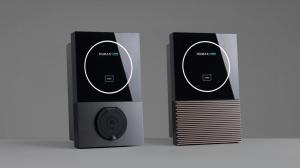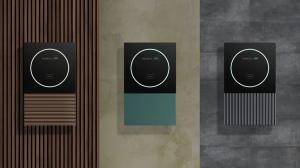Humax Unveils MX7: V2G-Ready EV Home Chargers
V2G-ready chargers feature integrated PLC module and ISO 15118 protocol for bi-directional charging through digital communication with EVs
Humax Co., Ltd. (KOSDAQ:Humax)
SEONGNAM-SI, GYEONGGI-DO, SOUTH KOREA, April 17, 2025 /EINPresswire.com/ -- - Humax launches MX7 next-generation, V2G-ready range designed for both consumer and business EV charging- V2G-ready chargers feature integrated PLC module and ISO 15118 protocol for bi-directional charging through digital communication with EVs
- Intelligent, efficient charging compatible with most EV tariffs to optimize electricity costs
- Solar compatibility enables use of renewable energy sources
- Customizable design blends seamlessly into home environments
- Advanced safety features include temperature sensors, overcharge detection and tamper protection
- Available in socket-type and tethered models
Humax today announced the launch of the Humax MX7 – its second-generation EV charger designed for domestic and business fleet markets.
The Humax MX7 is a V2G-ready EV charger that enables users to benefit from vehicle-to-grid (V2G) functionality, along with multiple energy-saving and cost-optimizing features. Suitable for both home and commercial charging, the chargers will be available as socket-type and tethered models from June 2025.
V2G-ready Technology
The Humax MX7 series features an integrated Power Line Communication (PLC) module and ISO 15118 protocol, enabling seamless digital communication with EVs. This facilitates vehicle identification and future-ready V2G capabilities. The MX7 range has been engineered to support continuous software updates, enabling the addition of new smart features and ensuring long-term performance, flexibility and future compliance. All future Humax EV charger models will be equipped with an integrated PLC module with ISO 15118 as standard.
Intelligent and Cost-Efficient Charging
Humax MX7 chargers are compatible with most EV tariffs, helping users reduce electricity costs by charging during off-peak hours. Solar-compatible, they can also use surplus power from home solar systems for greener, more economical charging. Smart scheduling and adjustable charge levels provide complete control and customization.
Engineered for Safety
Safety is a top priority. The MX7 includes integrated temperature sensors, overcharge protection and a tamper-detection switch to ensure a secure and reliable charging experience.
Stylish and Customizable
The MX7 range has been designed to harmonize with modern home aesthetics. Users can personalize their chargers with a variety of interchangeable front facias. Installation is simple thanks to the charger’s hinged front panel, providing easy access during set-up.
Business Charging Made Simple
The MX7 supports Auto Charge via ISO 15118, eliminating the need for RFID cards or apps. The user can simply plug in and start charging. For businesses, vehicle recognition streamlines the tracking of company car charging at employees’ homes, making reimbursements easier. The system integrates with leading third-party platforms and apps for enhanced management and operational efficiency.
Jeff Kim, president of Humax, commented, “Following extensive research, we have developed the MX7 to provide both residential and business users with a combination of efficient EV charging, energy optimization and cost reduction in one solution. With the growing adoption of electric vehicles and smart grid integration, and the desire for individuals and businesses to prove a positive return on their EV investment, we designed this range to ensure ultimate home energy optimization as well as straightforward management of EV fleets – helping consumers and organizations to reduce operational costs and even generate energy revenues. With this launch, we continue our commitment to innovation and sustainability in the EV ecosystem, empowering users to optimize their energy consumption and costs while contributing to a greener future.”
Further information on Humax EV Charging can be found at humaxcharging.com
Vincent Lee
Humax Co., Ltd.
sales|humaxcharging.com| |sales|humaxcharging.com
Visit us on social media:
Facebook
X
LinkedIn
Instagram
YouTube
Legal Disclaimer:
EIN Presswire provides this news content "as is" without warranty of any kind. We do not accept any responsibility or liability for the accuracy, content, images, videos, licenses, completeness, legality, or reliability of the information contained in this article. If you have any complaints or copyright issues related to this article, kindly contact the author above.
A Voice of Light: Viviana Puello’s Journey Through Music, Film, and Soul
Construction Mats Market: Growth, Trends, Opportunities & Forecast, 2021 - 2031
'Retired But Ready' Debuts as the Go-To Digital Space for Retirees Seeking Purpose, Connection, and Growth
Kalendarium
Więcej ważnych informacji
 Jedynka Newserii
Jedynka Newserii

 Jedynka Newserii
Jedynka Newserii

Prawo

KE proponuje nowy Fundusz Konkurencyjności. Ma pobudzić inwestycje w strategiczne dla Europy technologie
W środę 16 lipca Komisja Europejska przedstawiła projekt budżetu na lata 2028–2034. Jedna z propozycji zakłada utworzenie Europejskiego Funduszu Konkurencyjności o wartości ponad 400 mld euro, który ma pobudzić inwestycje w technologie strategiczne dla jednolitego rynku. Wśród wspieranych obszarów znalazła się obronność i przestrzeń kosmiczna. Na ten cel ma trafić ponad 130 mld euro, pięciokrotnie więcej niż do tej pory.
Firma
Były prezes PGE: OZE potrzebuje wsparcia magazynów energii. To temat traktowany po macoszemu

Choć udział odnawialnych źródeł energii w miksie energetycznym Polski jest stosunkowo wysoki i rośnie, to ten przyrost jest chaotyczny i nierównomiernie rozłożony miedzy technologiami – wskazuje Forum Energii. Dodatkowo OZE potrzebują wsparcia magazynów energii, a zdaniem Wojciecha Dąbrowskiego, prezesa Fundacji SET, ten temat jest traktowany po macoszemu. Brak magazynów powoduje, że produkcja energii z OZE jest tymczasowo wyłączana, co oznacza marnowanie potencjału tych źródeł.
Infrastruktura
Wzrost wynagrodzeń ekip budowlanych najmocniej wpływa na koszty budowy domu. Zainteresowanie inwestorów mimo to nieznacznie wzrasta

Budowa metra kwadratowego domu w Polsce kosztuje od 5,55 do 6 tys. zł w zależności od województwa – wynika z najnowszych analiz firmy Sekocenbud. Najdrożej jest w Warszawie, gdzie cena za metr kwadratowy domu przekroczyła już 6,2 tys. zł. Na przyrosty kosztów budowy domu wpływają zarówno drożejące materiały budowlane, jak i wyższe wynagrodzenia pracowników. Inwestorzy nie rezygnują jednak z budowy domów jednorodzinnych, co ma związek m.in. z wciąż wysokimi cenami mieszkań czy też obniżką stóp procentowych.
Partner serwisu
Szkolenia

Akademia Newserii
Akademia Newserii to projekt, w ramach którego najlepsi polscy dziennikarze biznesowi, giełdowi oraz lifestylowi, a także szkoleniowcy z wieloletnim doświadczeniem dzielą się swoją wiedzą nt. pracy z mediami.










.gif)

 |
| |
| |
|